![]()
![]()
![]()
Use LEFT and RIGHT arrow keys to navigate between flashcards;
Use UP and DOWN arrow keys to flip the card;
H to show hint;
A reads text to speech;
103 Cards in this Set
- Front
- Back
|
lysosome
|
an organelle composed of a phospholipid vesicle containing acids and hydrolytic enzymes; these fuse with phagocytotic and autophagocytic vesicles to degrade their contents
|
|
|
ribosome
|
the organelles that are the sites of protein synthesis; may be free (free in the cytoplasm) or bound (attached to endoplasmic reticulum)
|
|
|
endoplasmic reticulum
|
a tubular organelle composed of phospholipid bilayer; may be granular (rough), with bound ribosomes; or agranular (smooth indicating no bound ribosomes
|
|
|
golgi apparatus
|
organelle in which ATP is produced
|
|
|
triglyceride
|
a fat containing three fatty acid side chains attached to a glycerol
|
|
|
ATP
|
adenosine triphosphate, the fuel that runs the molecular machinery of the body, product of oxidative phosphorylation
|
|
|
organelles
|
small membranous bodies, each with a specific function and structure
|
|
|
polar molecules
|
molecules with charged groups or atoms
|
|
|
nonpolar molecules
|
molecules with no charged groups or atoms
|
|
|
cytoplasm
|
material bounded by a plasma membrane and cell wall
|
|
|
nucleolus
|
small region of nucleus assembles ribosomes
|
|
|
mitochondria
|
use energy from food to make high-energy compounds that the cell can use to power growth, development, and movement
|
|
|
cytoskeleton
|
network of protein filaments tha thelp the cell to maintain its shape
|
|
|
golgi apparatus
|
contains enzymes that attach carbohydrates and lipids and proteins
|
|
|
endocytosis
|
process of taking material into cell by means of pockets of cell membrane
|
|
|
phagocytosis
|
when large particles taken into cel by endocytosis extensions of cytoplasm surround and engulf large particles
|
|
|
exocytosis
|
removal of large amounts of material from the cell
|
|
|
rough ER
|
creates glycoproteins by attaching polysacharride groups to polypeptides
|
|
|
smooth ER
|
responsible for the synthesis of lipids and hormones
|
|
|
vesicles
|
small, spherically shaped sacs that bud from the outside surface of the golgi apparatus. They often migrate to and merge with the plasma membrane, releasing their contents outside of the the cell
|
|
|
mitochondria
|
carry out aerobic respiration (energy is obtained from carbohydrates)
|
|
|
nucleus
|
bounded by the nuclear envelope, the nucleus contains DNA, the hereditary information of the cell
|
|
|
microtubules
|
made of the protein tubulin and provide support and motility for cellular activities
|
|
|
microfilaments
|
Made of the protein Actin and are involved in cell motility, they are found un muscle cells
|
|
|
centrioles
|
a pair of centrioles gives rise to make the spindle apparatus
|
|
|
transport vesicles
|
move materials between organelles or between organelles and the plasma membrane
|
|
|
cell wall
|
a rigid structure that surrounds the cell membrane and provides support to the cell
|
|
|
lipids
|
fats, cholesterol; group of compounds that do not dissolve in water
|
|
|
phospholipid
|
has two fatty acid groups and a phosphorus group which makes them amphipathic (likes water and lipids)
|
|
|
hydrophobic
|
water fearing, form inner part of membrane
|
|
|
hydrophilic
|
water loving, form outer part of membrane
|
|
|
amino acids
|
20 different organic molecules that are used to make protein
|
|
|
vacuole
|
large vesicle, some act as lysosomes in plant and fungal cells, store water and other materials
|
|
|
chromatin
|
the DNA and proteins in the nucleus of a nondividing cell
|
|
|
chromosome
|
DNA and protein in a coiled, rod-shaped form that occurs during cell division
|
|
|
eukaryote
|
a cell that contains a nucleus and membrane-bound organelles
|
|
|
prokaryote
|
a unicellular organism that lacks a nucleus and membrane-bound organelles
|
|
|
fluid mosaic model
|
bilayer of lipids with imbedded, dispersed proteins that consists of phospholipids, cholesterol, and glycolipids
|
|
|
transport
|
a protein that spans the membrane; may provide a hydrophilic channel across the membrane that is selective for a particular solute. Some transport proteins hydrolize ATP as an energy source to actively pump substances across the membrane. Things going through membrane. Important for lymphatic activity
|
|
|
Discuss Histones
|
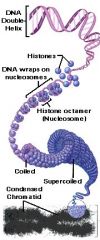
Histones are DNA binding proteins that are located in the cell nucleus. The 46 chromosomes in humans are all packaged into each cell nucleus (except in egg and sperm) in the human body. Each chromosome is a single, long thread of DNA (nearly 10 meters long) that must be packaged into the cell nucleus which is a few micrometers in diameter. Because the packaging of the DNA requires that stretches of the DNA remain accessible for gene transcription, packaging must be exact and permit selected portions of the DNA to be unraveled. The organized system of DNA packaging depends on histones that bind to the DNA and permit the DNA to wind around the histones in a precise fashion. Eight histone molecules assemble into a nucleosome, and the DNA wraps around this histone octamer. The nucleosomes themselves form a coil that is in turn coiled into a super coil which can fold into a condensed chromosome. The term chromatin refers to DNA that is visible in the light microscope. Because DNA is a single molecule, a single strand of DNA is far too small to be visualized in the light microscope. DNA becomes visible as chromatin once it has been wrapped around histones and coiled. (Resolution in the light microscope is limited to about 0.5 micrometers, which is about one fourth the width of a mitochondrion.)
|
|
|
Describe the structure of DNA
|
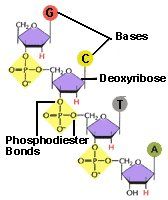
Each DNA molecule is composed of two side chains of the phosphorylated sugar, deoxyribose. The sugar molecules are linked one to the next through phosphate groups (phosphodiester bonds) located on the 3 prime and 5 prime carbons of the deoxyribose. These linkages between sugars form the backbone of the molecule. Each phosphorylated sugar is covalently linked to one of four bases, Adenine, Cytosine, Thymine, or Guanine which are abbreviated A, C, T, and G respectively
|
|
|
Describe the DNA nucleotide pairings
|
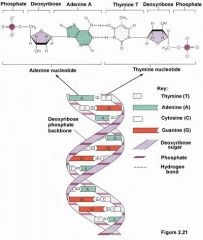
n DNA, Adenine always pairs with Thymine (A-T) and cytosine always pairs with guanine (C-G). This pairing occurs because of hydrogen bonding between the bases in the middle of the molecule (Fig. 2.21). The strength of the hydrogen bonding is insufficient to permit the stable formation of any other base pairs. The base pairing also leads to the helical pitch characteristic of DNA
|
|
|
Describe DNA replication
|
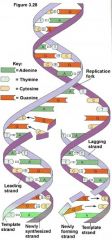
DNA replication begins when an enzyme uncoils the DNA molecule and the two strands of the molecule become separated as the hydrogen bonds holding the bases together are broken to form the replication fork. Breaking these bonds yields two strands of DNA that can be used as templates (the template strands) to form a new molecule of DNA. Because one of the strands in each of the new DNA molecules is an old strand, the process of DNA replication is said to be semi conservative. Once the two strands are separated, the enzyme DNA polymerase can pair new bases with the old bases on the template strand so that there again is A-T and C-G bonding. The DNA polymerase also forms the phosphodiester links that connect the deoxyriboses one to another in the backbone of the molecule. Because of the way that the DNA polymerase "walks" along the DNA strand, one strand, the leading strand, is replicated continuously by adding one base at a time along the length of the conserved strand. On the other strand, the lagging strand, replication progresses in fits and starts as the DNA coil is unraveled to expose new bases needing the appropriate mate
|
|
|
Describe the peptide bond
|
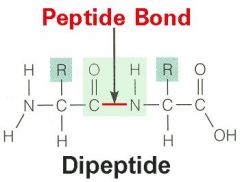
Each amino acid contains an amine (NH2) group, a carboxylic acid (COOH) group and an R group; the R group is specific to the type of amino acid and may be charged (hydrophilic) or uncharged (hydrophobic). There are 20 amino acids whose identity is determined by the R group. The peptide bond is the site where amino acids are linked one to another in the chain. The peptide bond is formed when the hydroxyl (OH) on the carboxylic acid and the H on the amino group combine to form water and permit the N of the amino group to form a covalent bond with the C of the carboxylic acid
|
|
|
Describe RNA splicing
|
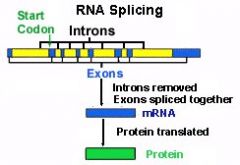
Only portions of the transcript are used to produce protein. The stretches of the DNA that are not expressed are said to be non informational and are called introns. The stretches of DNA that are expressed as protein are called exons. The RNA transcript that is complementary to the DNA is cut and spliced back together in the nucleus so that only regions of the RNA that are complementary to the exons remain. This edited mRNA then leaves the nucleus through a nuclear pore to enter the cytoplasm
|
|
|
What are the four types of tissues?
|
1. epithelia
2. connective 3. muscle 4. nervous |
|
|
Characteristics of epithelia:
|
1. They are composed of cells with little intercellular material between.
2. The cells are interconnected by the cell junctions described earlier. 3. The cells have polarity, that is they have specialized surfaces, apical and basal. 4. The basal side is attached via hemidesmosomes to the basal lamina which is mostly extracellular matrix molecules. 5. They contain nerve endings 6. They are avascular, receiving nourishment and oxygen from vessels coursing through the connective tissue beneath it. 7. These cells retain a remarkable ability for regeneration through cell division, which makes it susceptible to producing tumors. Indeed, cancers that originate as epithelial cells are called carcinomas. |
|
|
The two main branches are simple and stratified
|
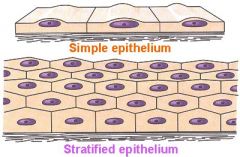
1. Simple epithelia are composed of a single layer of cells (See Epithelium/Classification).
2. Stratified epithelia are layered. |
|
|
The simple epithelia are further categorized according to their shape and location into four groups.
|
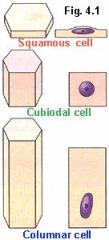
1. Squamous
2. Cuboidal 3. Columnar 4. Pseudostratified |
|
|
Squamous (flattened) epithelia
|
are found in places where there is an advantage to shortening the diffusion distances such as in regions of gas exchange in the lungs and in the lining of capillaries called the endothelium
|
|
|
Cuboidal epithelia
|
are found in the kidney. Transport of water and salts occurs across this epithelium which you will hear more about in the discussion about excretion.
|
|
|
Columnar epithelia
|
are found mostly lining the walls of the stomach small and large intestine. The apical surface of these cells is often thrown into a series of folds called microvilli. Each microvillus contains a bundle of actin filaments to give it shape. Some may be ciliated.
|
|
|
Pseudostratified epithelia
|
at first glance appear to be stratified or layered, but on closer inspection it is obvious that each cell has its basal surface attached to the basal lamina. Because the cells are somewhat irregularly shaped, a random section through one of these epithelia shows some cells reaching the basal lamina and other above it. These epithelia are found in the trachea and bronchi and are usually ciliated. The beating of the cilia propels mucous and trapped particles out of the lungs and trachea to be swallowed.
|
|
|
stratified squamous epithelium
|
One of the most common, Skin contains this type of epithelium. In the case of skin, the upper layers are dead and contain a great deal of keratin. Nonkeratinzed stratified squamous epithelia are found in the linings of the mouth esophagus and vagina. Places that need to be protected from abrasion.
|
|
|
transitional epithelium
|
is a type of stratified eplithelium. These cells line the bladder ureters, and part of the urethra. They provide the advantage that can stretch. The basal layers are cuboidal or columnar. The apical layer is often squamous particularly if the bladder is distended. As the bladder fills the cell layer can go from 6 layers to 3.
|
|
|
Endocrine glands
|
are ductless glands. They often have ducts to the surface early in development, but these ducts are lost and endocrine glands secrete hormones. You will hear more about these in the lectures about the endocrine system.
|
|
|
Exocrine glands
|
have ducts. Some of the epithelium of the gland is dedicated to ducts and some is dedicated to secretion. The secretory portions are surrounded by connective tissue that is invested with vasculature for the delivery of stuff to be processed into the secretion.
|
|
|
Glands
|
is composed of one or more cells that makes and secretes a particular product. These products are made in the ER and Golgi and packaged for secretion in vesicles called granules. Are divided into two groups endocrine and exocrine.
|
|
|
ion
|
charged particle with unequal numbers of protons and electrons
|
|
|
electrolytes
|
salts that ionize in water and form solutions capable of conducting electricity
|
|
|
free radicals
|
chemical particles with an odd number of electrons. they are short lived and combine quickly with molecules such as fats, proteins and DNA
|
|
|
antioxidant
|
chemical that neutralizes free radicals
|
|
|
valence
|
the charge on an anion
|
|
|
molecules
|
chemical particles composed of two or more atoms united by a covalent bond
|
|
|
compounds
|
molecules composed of two or more different elements
|
|
|
isomers
|
molecules with identical molecular formulae but different arrangements of their atoms
|
|
|
molecular weight (MW)
|
the sum of the atomic weights of its atoms
|
|
|
chemical bond
|
a molecule is held together and molecules are attracted to each other by forces
|
|
|
ionic bond
|
the attraction of a cation to an anion
|
|
|
nonpolar covalent bond
|
a bond where shared electrons spend approximately equal time around each nuleus; the strongest of all chemical bonds
|
|
|
polar covalent bond
|
a bond where electrons spend significantly more time orbiting one nucleus than they do the other; they lend their negative charge to the region where they spend the most time
|
|
|
hydrogen bond
|
a weak attraction between a slightly positive hydrogen atom in one molecule and a slightly negative oxygen or nitrogen atom in another
|
|
|
mixture
|
consists of substances that are physically blended but not chemically combined; each substance retains its own chemical properties
|
|
|
hydrophilic
|
substances that dissolve in water, such as sugar
|
|
|
hydrophobic
|
substances that do not dissolve in water, such as fats
|
|
|
adhesion
|
the tendency of one substance to cling to another
|
|
|
cohesion
|
the tendency of molecules of the same substance to cling to one another
|
|
|
calorie
|
the amount of heat required to raise the temperature of 1 g of a substance by 1 degree C
|
|
|
solution
|
consists of particles of matter called the solute mixed with a more abundant substance (usually water) called the solvent.
- particles under 1 nanometer (nm); cannot be visually distinquished from each other - does not scatter light; transparent - particles will pass through ost selectively permeable membrances - does not separate from solvent when allowed to stand |
|
|
solute
|
can be a gas, solid or liquid
|
|
|
colliod
|
defined by the following properties:
- particles range from 1 to 100 nm - scatter light, so are usually cloudy - particles are too large to pass through most selectively permeable membranes - particles still small enough to remain permanently mixed with solvent |
|
|
suspension
|
- particles exceed 100 nm in size
- render suspension cloudy or opaque - particles are too large to penetrate selectively permeable membranes - too heavy to remain permanently suspended, so separate |
|
|
emulsion
|
suspension of one liquid in another, such as oil and vinegar salad dressing
|
|
|
molarity
|
the number of moles of solute per liter of solution
|
|
|
lipid
|
a hydrophobic organic molecule, usually composed only of carbon, hydrogen and oxygen, with a high ration of hydrogen to oxygen
|
|
|
fatty acid
|
a chain of usually 4 to 24 carbon atoms with a carboxyl group at one end and a methyl group at the other
|
|
|
saturated fatty acid
|
has as much hydrogen as it can carry; no more hydrogen could be added without exceeding four covalent bonds per carbon atom
|
|
|
unsaturated fatty acid
|
some carbon atoms are joined by double covalent bonds
|
|
|
polyunsaturated fatty acides
|
contains many carbon double bonds
|
|
|
essential fatty acids
|
cannot be synthesized by the human body, so must be obtained from the diet
|
|
|
triglyceride
|
a molecule consisting of three fatty acids covalently bonded to a three-carbon alcohol called glycerol
|
|
|
phospholipids
|
similar to neutral fats except that in place of one fatty acid, they have a phosphate group which in turn is linked to other functional groups
|
|
|
amphiphilic
|
phospholipds are said to be amphiphilic because of their dual nature: the two fatty acid "tails" of the molecule are hydrophobic, but the phosphate "head" is hydrophilic
|
|
|
eicosanoids
|
20-carbon compounds derived from a fatty acid called arachidonic acid; they function primarily as hormonelike chmical signals between cells
|
|
|
prostoglandins
|
eicosanoid in which five of the carbon atoms are arranged in a ring
|
|
|
steroid
|
a lipid with 17 of its carbon atoms arranged in four rings
|
|
|
cholesterol
|
a "parent" steroid from which other steroids are synthesized; synthesized only by animals and is not present in vegetable oils or other plant products
|
|
|
protein
|
a polymer of amino acids in which each amino acids has a central carbon atom with an amino and a carboxyl groupd bound to it
|
|
|
amino acid
|
has a central carbon atom that has an amino (-NH2) and a carboxyl (-COOH) group bound to it; the 20 amino acids used to make proteins are identical except for a third functional group called the radical (R group) attached to the central carbon
|
|
|
peptide
|
any molecule composed of two or more amino acids joined by peptide bonds
|
|
|
peptide bond
|
formed by dehydration synthesis, joins the amino group of one amino acid to the carboxly group of the next
|
|
|
oligopeptide
|
chains of fewer than 10 to 15 amino acids
|
|
|
polypeptide
|
chains of amino acids larger than 15
|

